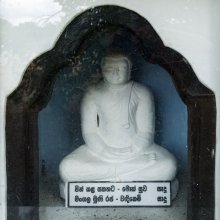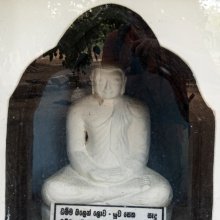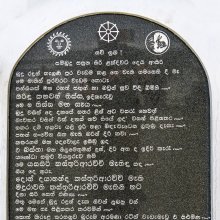Suva: 8 definitions
Introduction:
Suva means something in Hinduism, Sanskrit, Buddhism, Pali, Marathi, Jainism, Prakrit, biology. If you want to know the exact meaning, history, etymology or English translation of this term then check out the descriptions on this page. Add your comment or reference to a book if you want to contribute to this summary article.
Images (photo gallery)
In Hinduism
Purana and Itihasa (epic history)
Source: Cologne Digital Sanskrit Dictionaries: The Purana IndexSuva (सुव).—One of the seven worlds.*
- * Matsya-purāṇa 60. 2.

The Purana (पुराण, purāṇas) refers to Sanskrit literature preserving ancient India’s vast cultural history, including historical legends, religious ceremonies, various arts and sciences. The eighteen mahapuranas total over 400,000 shlokas (metrical couplets) and date to at least several centuries BCE.
Biology (plants and animals)
Source: Wisdom Library: Local Names of Plants and DrugsSuva [સુવા] in the Gujarati language is the name of a plant identified with Anethum graveolens L. from the Apiaceae (Carrot) family. For the possible medicinal usage of suva, you can check this page for potential sources and references, although be aware that any some or none of the side-effects may not be mentioned here, wether they be harmful or beneficial to health.
Source: Google Books: CRC World Dictionary (Regional names)Suva in India is the name of a plant defined with Anethum graveolens in various botanical sources. This page contains potential references in Ayurveda, modern medicine, and other folk traditions or local practices It has the synonym Peucedanum sowa (Roxb. ex Fleming) Kurz (among others).
Example references for further research on medicinal uses or toxicity (see latin names for full list):
· Flora of Ecuador (1976)
· Fl. Libya (1985)
· Cytologia (1986)
· Pakistan Journal of Botany (1982)
· Candollea (1980)
· Acta Phytotaxonomica Sinica (1984)
If you are looking for specific details regarding Suva, for example health benefits, extract dosage, chemical composition, side effects, diet and recipes, pregnancy safety, have a look at these references.

This sections includes definitions from the five kingdoms of living things: Animals, Plants, Fungi, Protists and Monera. It will include both the official binomial nomenclature (scientific names usually in Latin) as well as regional spellings and variants.
Languages of India and abroad
Pali-English dictionary
Source: BuddhaSasana: Concise Pali-English Dictionarysuva : (m.) a parrot.
Source: Sutta: The Pali Text Society's Pali-English DictionarySuva, (cp. Sk. śuka) a parrot J. I, 324; IV, 277 sq.; VI, 421; 431 sq. (the two: Pupphaka & Sattigumba); DhA. I, 284 (°rājā). fem. suvī J. VI, 421. (Page 720)

Pali is the language of the Tipiṭaka, which is the sacred canon of Theravāda Buddhism and contains much of the Buddha’s speech. Closeley related to Sanskrit, both languages are used interchangeably between religions.
Marathi-English dictionary
Source: DDSA: The Molesworth Marathi and English Dictionarysuvā (सुवा).—m ( H) A large needle; a packing needle.
Marathi is an Indo-European language having over 70 million native speakers people in (predominantly) Maharashtra India. Marathi, like many other Indo-Aryan languages, evolved from early forms of Prakrit, which itself is a subset of Sanskrit, one of the most ancient languages of the world.
Prakrit-English dictionary
Source: DDSA: Paia-sadda-mahannavo; a comprehensive Prakrit Hindi dictionary1) Suva (सुव) in the Prakrit language is related to the Sanskrit word: Svap.
2) Sūva (सूव) also relates to the Sanskrit word: Sūpa.
Prakrit is an ancient language closely associated with both Pali and Sanskrit. Jain literature is often composed in this language or sub-dialects, such as the Agamas and their commentaries which are written in Ardhamagadhi and Maharashtri Prakrit. The earliest extant texts can be dated to as early as the 4th century BCE although core portions might be older.
Kannada-English dictionary
Source: Alar: Kannada-English corpusSūva (ಸೂವ):—[noun] any or several kinds of liquid foods made using dhal, spices, vegetables etc. for mixing it with rice.
Kannada is a Dravidian language (as opposed to the Indo-European language family) mainly spoken in the southwestern region of India.
See also (Relevant definitions)
Starts with (+609): Cuva, Cuva-metaiaka, Cuva-metaikirushi, Cuvacakacam, Cuvacakam, Cuvacakkulal, Cuvacakkuttu, Cuvacakocam, Cuvacam, Cuvacamvankal, Cuvacan-kattierru, Cuvacanaviruttam, Cuvacanirunayam, Cuvacapantam, Cuvacatiyam, Cuvaccam, Cuvaci, Cuvai, Cuvakai, Cuvakariyam.
Ends with (+12): Ahishuva, Akshosuva, Aracuva, Bhagakhosuva, Birsuva, Cusuva, Cuva, Gamsuva, Ghamsuva, Hamsuva, Jalavishuva, Kesuva, Khosuva, Komdamusuva, Kshuva, Kusuva, Lahsuva, Mahavishuva, Musuva, Pamsuva.
Full-text (+5): Suvas, Supa, Makaviyakiruti, Suvasa, Prasuva, Vyahriti, Suvakantha, Svardhaman, Svam, Svap, Suvanavamathu, Phattar-suva, Sacakka, Patthar-suva, Paratari, Shaliya, Shuka, Anahuti, Suvana, Virasu.
Relevant text
Search found 26 books and stories containing Suva, Suvā, Sūva; (plurals include: Suvas, Suvās, Sūvas). You can also click to the full overview containing English textual excerpts. Below are direct links for the most relevant articles:
Rig Veda (translation and commentary) (by H. H. Wilson)
Thirty minor Upanishads (by K. Narayanasvami Aiyar)
Tarasara Upanishad of Shukla-Yajurveda
Subala Upanishad of Shukla-yajurveda, Chapter X
Vedic influence on the Sun-worship in the Puranas (by Goswami Mitali)
Part 5 - Sūrya (the Healer) < [Chapter 2 - Salient Traits of the Solar Divinities in the Veda]
Part 11 - Savitṛ (the Healer) < [Chapter 2 - Salient Traits of the Solar Divinities in the Veda]
Part 2 - Purāṇic Sūrya, the Atmospheric Deity < [Chapter 4 - Vedic Influence on the Sun-Worship in the Purāṇas]
Bharadvaja-srauta-sutra (by C. G. Kashikar)
Taittiriya Upanishad (by A. Mahadeva Sastri)
Lesson V - Contemplation of the Vyāhṛtis < [Book I - Shiksha Valli]
Lesson VI - Contemplation of Brahman < [Book I - Shiksha Valli]
Taittiriya Upanishad Bhashya Vartika (by R. Balasubramanian)
Verse 1.93 < [Book 1 - Śīkṣāvallī]
Verse 1.92 < [Book 1 - Śīkṣāvallī]
Verse 1.118-120 < [Book 1 - Śīkṣāvallī]


